
The Battle of Wittstock took place during the Thirty Years' War (1618–1648). It was fought on 24 September or 4 October 1636. A Swedish-allied army commanded jointly by Johan Banér and Alexander Leslie decisively defeated a combined Imperial-Saxon army, led by Count Melchior von Hatzfeld and the Saxon Elector John George I.
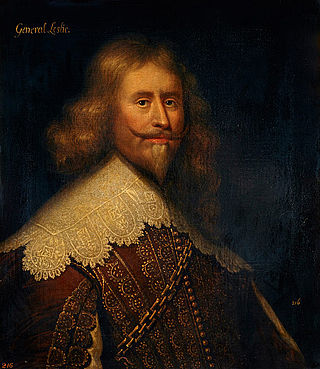
Alexander Leslie, 1st Earl of Leven was a Scottish military officer and peer. Born illegitimate and raised as a foster child, he subsequently advanced to the rank of field marshal in Swedish Army, and in Scotland became Lord General in command of the Army of the Covenanters, a privy councillor, captain of Edinburgh Castle, Lord Balgonie and Earl of Leven. In England he commanded the Army of the Solemn League and Covenant and was senior commander of the Army of Both Kingdoms (1642–1647). Leslie served in the Thirty Years' War, the Bishops' Wars, and most of the English Civil War, fighting primarily in the First English Civil War. Leslie would live a long life, dying roughly at the age of 80 or 81.

David Leslie, 1st Lord Newark was a Scottish military officer and peer. During the Thirty Years' War, he joined in the Swedish Army in 1630 and served under Alexander Leslie. Returning to Scotland in the final days of the Bishops' War, Leslie fought in the English Civil War and Scottish Civil Wars on the side of the Covenanters and Royalists. After the Stuart Restoration, Leslie was raised to the peerage of Scotland as Lord Newark by Charles II of England.
General William Baillie was a Scottish professional soldier who fought for the Dutch and later commanded a regiment under Gustavus Adolphus in Sweden. Previously having seen service in the Scots-Dutch brigade, he joined the Scottish regiment of Colonel Alexander Hamilton in Sweden before going on to command a German regiment. Records of his service in the Swedish army fade out after 1633. He returned to Scotland in 1639. He served with the Army of the Covenant in 1639 at Duns Law with the rank of colonel.
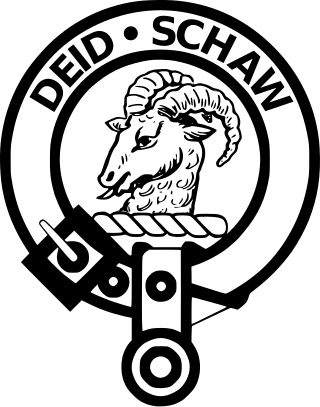
The Clan Ruthven is a Lowland Scottish clan.

Patrick Ruthven, 1st Earl of Forth and 1st Earl of Brentford was a Scottish nobleman, general, and diplomat.

James King, 1st Lord Eythin (1589–1652) was a Scottish soldier, who served in the Swedish army, and who later supported King Charles I in the Bishops' Wars, and then later in the English Civil War.
Robert Monro, was a famous Scottish General, from the Clan Munro of Ross-shire, Scotland. He held command in the Swedish army under Gustavus Adolphus during Thirty Years' War. He also fought for the Scottish Covenanters during the Bishop's Wars in Scotland and commanded the Scottish Covenanter army during the Irish Confederate Wars. He was the author of a diary recounting his military experiences during the Thirty Years' War, published as Monro, His Expedition With the Worthy Scots Regiment Called Mac-Keys.

Sir John Hepburn was a Scottish soldier who fought in wars in continental Europe achieving the rank and status of Maréchal de France.
Colonel Robert Munro of Foulis, also known as the Black Baron, was traditionally the 18th Baron of Foulis in Scotland. He was a soldier of fortune, who served in Germany under the banners of Gustavus Adolphus, king of Sweden. It is not certain how he got his epithet of the 'Black Baron', but quite possibly it was from the colour of his hair rather than any perceived martial ferocity. Although this Robert Munro is traditionally 18th Baron and 21st overall chief of the Clan Munro, he is only the 11th Munro chief that can be proved by contemporary evidence.

The siege of Stralsund was a siege laid on Stralsund by Albrecht von Wallenstein's Imperial Army during the Thirty Years' War, from 13 May 1628 to 4 August 1628. Stralsund was aided by Denmark and Sweden, with considerable Scottish participation. The lifting of the siege ended Wallenstein's series of victories, and contributed to his downfall. The Swedish garrison in Stralsund was the first on German soil in history. The battle marked the de facto entrance of Sweden into the war.

Robert Douglas, Count of Skenninge, Baron of Skalby, was a Scottish cavalry general during the Thirty Years' War rising to the rank of Field Marshal (1657–1662) in the Swedish-Polish wars that followed. He founded the Swedish branch of Clan Douglas.

Lord James Douglas (1617–1645) was a Scottish nobleman and soldier.
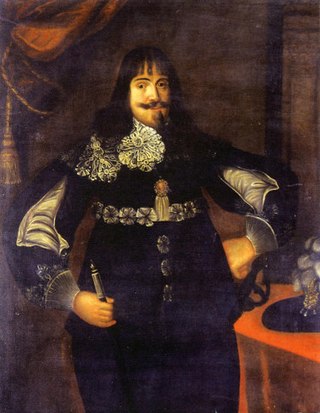
James Lumsden (1598–1660) was a Scottish soldier who served in the Swedish army of Gustavus Adolphus during the Thirty Years' War, and subsequently commanded Scottish Covenanter armies.
Alexander Seaton or Seton was a Scottish soldier in Danish service during the Thirty Years' War. He briefly served as a governor in the Battle of Stralsund and as an admiral in the Torstenson War.

Lennart Torstensson, Count of Ortala, Baron of Virestad, was a Swedish Field Marshal and military engineer.
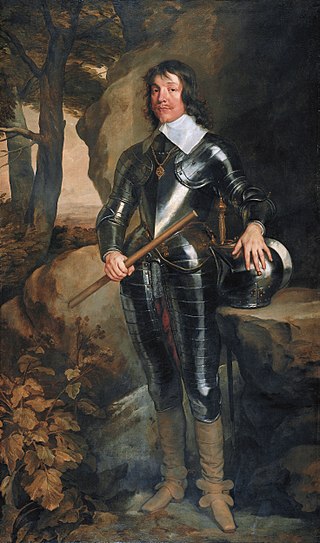
James Hamilton, 1st Duke of Hamilton, KG, PC, known as the 3rd Marquess of Hamilton from March 1625 until April 1643, was a Scottish nobleman and influential political and military leader during the Thirty Years' War and the Wars of the Three Kingdoms.

There was a complicated involvement between Scotland and the Thirty Years' War of 1618–1648. Scotland and the Scots were heavily entangled in both the diplomatic and military events which centred on the Holy Roman Empire. There were a number of reasons for this participation.
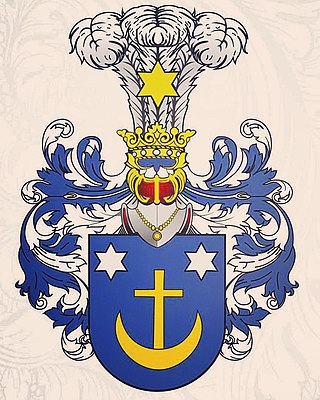
The Kravtsov of Orenburg family is the name of Russian noble family of Scottish-Russian origin. The family is enlisted into the pedigree books of the Orenburg Cossacks Host and Nizhny Novgorod Governorate.
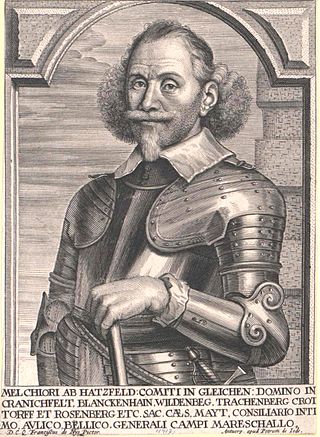
Melchior Graf von Gleichen und Hatzfeldt was an Imperial Field Marshal. He fought in the Thirty Years' War first under Albrecht von Wallenstein and Matthias Gallas, then received an independent command in Westphalia. Usually successful with a smaller corps on this secondary front and victorious at Vlotho and Dorsten, he lost at Wittstock and Jankau in his brief intermezzos as commander of major armies.
















